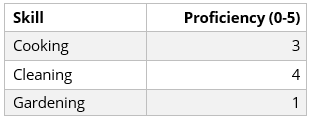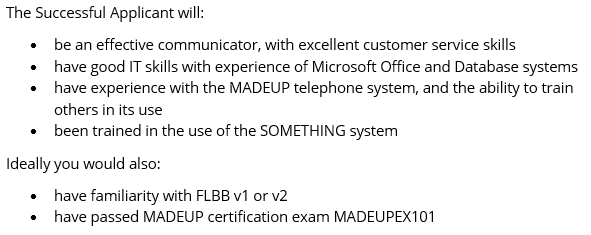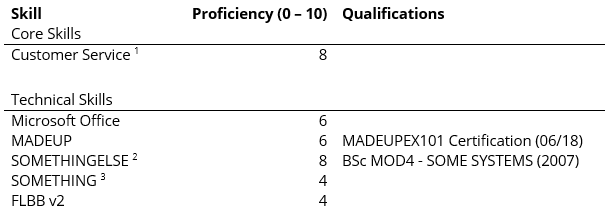
Skill Matrix 2019 – When and how to add one to your CV/Résumé
When creating a job advert, employers will often list the skills that they would expect the successful candidate to be capable of demonstrating. So when preparing your CV (Curriculum Vitae) or résumé for a job application, it is worth taking the time to include a Skill Matrix to provide the recruiter with a quick way to match you to the job.
This article looks at what makes up a skill matrix, and how to successfully implement one into your CV.
What is a Skill Matrix
A Skills Competency Matrix is simply a table representation of your skills, and your perceived competency in each of those skills. Typically you’ll list your key skills down in the first column, and then in the second column try to gauge your skill level (also called competency or proficiency) with a number.
It could be simple and direct list like this:

Or a more complex and visual example like the one shown here:

Whether you choose the simple or complex design, or one of your own making, the value of a skill matrix is that it is a simple and consistent way for you to present your skill range. In doing this, other people can then quickly get an understanding of your competency across all of your skills.
Why is this important?
It gets you past the gate keeper

The first person to see your CV is not likely to be anyone related to the job you’re applying for. In most medium to large companies, applications will first by filtered by a recruitment officer or someone similar in the Human Resources department. These people are generally well experienced in the recruitment process, but will only have the job advert along with (maybe) a bit of additional background information on the role itself. It’s their job to quickly sort the wheat from the chaff, and by providing a quick reference to the skills being asked for, you’re making their job a whole lot easier and increasing the chances of your CV making it to the next step.
It helps match skills that the reader may not know about

Your CV may be scrutinised by multiple people from many different disciplines as it traverses the application process. While some of them may be fully versed in your areas of expertise and immediately be able to see that you’re the right person for the job, others may need a bit of guidance.
A skills matrix can help you to break down your specialisations and experience, and match them to relevant qualifications.
It gives your potential interviewer specific points to focus on

Teasing information from applicants can occasionally be a bit like pulling teeth. The interviewer may get that feeling that there’s something interesting, something promising about an interviewee, but for some reason they’re just not selling some of their best qualities.
Experienced interviewers are able to glean this information out of the interviewee by reading between the lines of the rest of your CV, but there’s no harm in handing them a concise list of your skills and experiences which they can pick through and ask specific questions about.
When to include a Skills Matrix in your CV
Generally speaking, you should include a Skill Matrix if any of the following are true:
- The job description is asking for more than 3 specific skill requirements, or more than 6 desired skills.
- You lack relevant qualifications or professional experience in the required skills, but have sufficient personal experience in them (be warned that if you’re asked to an interview, you will be expected to back this up).
- The role is particularly technical, and you want to put across that you have a clear understanding of what would be expected of you.
- The job advert is overly vague, and you want to cover your bases to show you have enough relevant skills to be a valid candidate.
Building your Skills Matrix
Step 1: Examine the Job Description for Relevant Skills

Sometimes adverts will provide you with a nice, concise list of the skills that a successful candidate would possess, other times you have to work a bit harder to figure this out. Let’s take a look at a few examples.
“Possess excellent IT knowledge, particularly in Excel and Word”
This is a clear indication of two skills that you will need and should include in your Skill Matrix: Microsoft’s Excel and Word products. It also provides you with a hint that other IT knowledge may be desirable, so if you also have experience with PowerPoint for example, it could be beneficial to include it.
“Working knowledge of systems – Chess, Quality Systems, T&A, MPS, Change Notes, etc.”
Another clear list of systems that you would be expected to have a “working knowledge” of, and which can also provide you with an opening to include similar or related systems. For example, let’s say that “Chess” has a sister product called “Draughts” which you have experience in. Including this in your skill matrix displays evidence that you may have transferrable, or more in-depth experience than someone with just knowledge of “Chess”.
“…keep our business running smoothly by resolving complex … server and infrastructure issues”
Here is a more vague statement which you may be able to match skills to. They’re looking for someone with experience providing both server and infrastructure support. So key skills would be your knowledge in specific server operating systems (Windows Server 2018, Ubuntu Server, etc.), and infrastructure skills such as network patching, routing and switching, DNS, DHCP, etc.
Step 2: Ask yourself “is there anything else I could add?”

So you’ve added the skills asked for in the job description (primary skills), as well as maybe some similar or related skills (secondary skills). Now you need to think outside the box and try to consider: what are the top 3 skills you’ve gained which are not asked for, but which could potentially bring value to the company (tertiary skills).
Tertiary skills are difficult, and if not thought out clearly could actually harm your application by including them. Generally I would categorise tertiary skills into three sub-types:
Transferrable Skills
Transferrable skills are skills which weren’t asked for but are similar and immediately apparent in how they could be matched across. This will be things like if you attained a certain rank in your previous military career, then you can transfer your knowledge of leadership to the skills required of a management position.
Value-Bringing Skills
These are skills which are not immediately obviously related to the job, but could bring value anyway. If you’re an experienced IT support technician looking to become a marketer, your skills may not seem immediately relevant. But if the company is looking to develop a new digital product range then your experience suddenly becomes relevant.
Everything Else
Anything that isn’t transferrable or value-bringing falls into this category. These could be things you’re incredibly proud of, but if they’re not relevant then they shouldn’t be included in your skill matrix as they may detract from your more important (to the application) skills.
Step 3: Define your Scales

You’re going to be rating your skills all on the same scale for clarity, so it’s best to define this now. This will depend largely on how many skills you have, and your breadth of levels of experience at each of them.
If you have a list of 5 skills and you consider yourself to be very proficient at all of them, a simple 3 point (0 = little to no experience, 3 = extremely proficient and able to teach or lead others) may be sufficient.
Personally, I prefer a 10 point system as it allows for a bit of granularity when comparing similar skills, but doesn’t go too far or become too complex (“I’m definitely a level 68 tea brewer, but my coffee, while nice, tends to be a bit too weak, so I’d only judge myself to only be level 67 at that.”).
As long as you’re comparing all of your skills on the same scale it doesn’t matter too much, find something that works for you.
Step 4: Judge Thyself

Now that you have a list of skills it’s time to judge your own ability to perform those skills proficiently.
List each skill (categorising them where appropriate) in a table. Then next to them add a value (according to your pre-defined scale) for how proficient or experienced you feel you are in that skill.
Try to ask yourself questions such as “could I work on a project on my own, without any support, using this skill?“, or “could I train others in this skill?” to help gauge your skill level.
Consider also adding a “Qualifications” column for linking the skill to your qualifications listed elsewhere on your CV, or a column for the number of years of experience you have in this skill.
Step 5: Check your Skill Matrix for Length and Relevance

Now that you have your skill list it’s time to be brutal with yourself. It is generally recommended that CVs should be no longer than 3 – 5 pages, if your skill matrix takes up two or more of them then you have listed too many skills! A skill matrix doesn’t have a minimum length, but it should never extend beyond a single sheet of A4.
Look at each skill, referencing back to the job description, and ask yourself: “Is this skill relevant to the post I am applying?” If the answer is “no”, then just remove it because it will only serve to distract the recruiter from your other, more applicable skills.
An Example Skill Matrix
Taking all of this information, let’s look at a quick example of a job description’s skill list, and a skill matrix for a fictional applicant which could be included in their CV.
Example Job Skill List

Matching Skill Matrix

Here you can see that the essential skills have been matched directly by the applicant’s experience where applicable (1). In addition to this they have made sure to include the desired skills, and have also padded it out with a related skill.
In this example, we can see that the applicant doesn’t rate their abilities too highly in the required “SOMETHING” system, giving it a proficiency of just 4 (3). However, in this example, the applicant does have extensive experience in a similar system, “SOMETHINGELSE” (2). This boosts the applicant’s potential as they show: a) some amount of experience in the system and a desire to develop this skill; and b) transferable skills from a similar system.
Maintaining a Personal Skill Matrix
Once you’ve been through this process once, you may begin to realise that it’s actually worth maintaining a skill matrix for yourself to make it easier to pull out the relevant information when next applying for a job.
Did you know that, even though they were built for big business, you can use skill management tools like Expertise Matrix (EMX)to manage your own skills for as little as 30 pence per month (if you’re in the UK, or approx 37 cents US, 0.34 euros, etc)?
Yes, you read that right. If you paid for an EMX subscription for yourself for your entire working life (let’s say 36 years according to this source), then for that whole period it would cost less than one year of Amazon Prime!
While its default packages are aimed at their business customers, individuals are welcome to create a Custom Package with just one user and take advantage of this powerful skill management platform for less than most people pay for a loaf of bread!
Hint: it’s got a 30 day free trial anyway, so it’s worth taking 5 minutes out of your day to see if it can work for you.
Check out Expertise Matrix here.
A Trio of Final Quick Hints
When filling in your skill matrix, try to remember three important hints:
- It’s ok to say you have a low proficiency (albeit more than zero) in a desirable or non-essential skill. By including it, you’re displaying that you have shown interest in and have the capacity for developing that skill. It’s even ok to say it for one or two essential skills as long as you can justify it with experience in closely related or transferable skills.
- Don’t lie, and be modest. If you’re giving yourself top-marks in all of the skills asked for then you have a chance of sowing the seeds of doubt in the recruiter, and you had better be prepared to back it up at interview.
- This may sound counter-intuitive, but try to avoid giving yourself top marks at all. Some recruiters will view this negatively as a sign that you feel you don’t have any more room to grow.
Like this article?
Thanks for taking the time to read this article. If you liked it or found it helpful, please share it with your friends and colleagues.
Like the article? Share with your friends:
 Int64 Software Ltd
Int64 Software Ltd